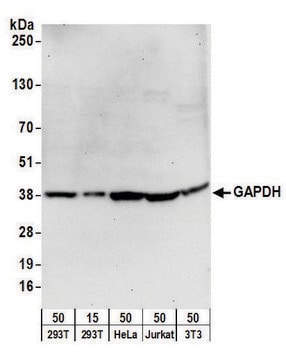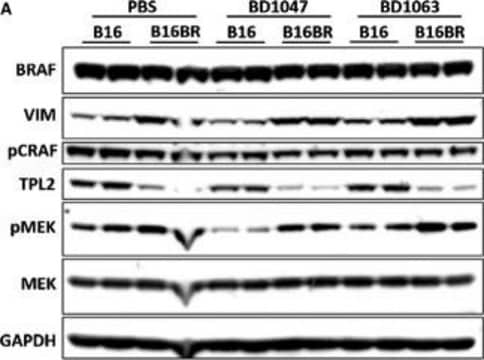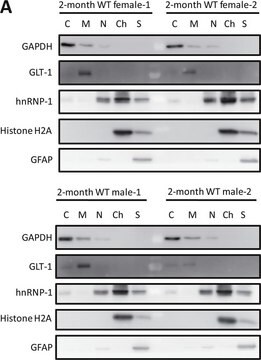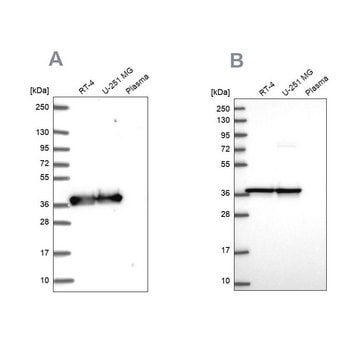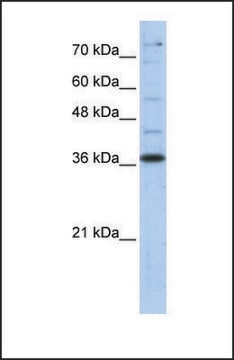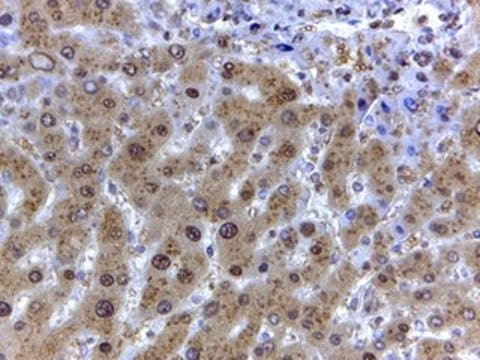G8795
Monoclonal Anti-GAPDH antibody produced in mouse
clone GAPDH-71.1, purified from hybridoma cell culture
Synonyme(s) :
Anti-G3PD, Anti-G3PDH, Anti-Glyceraldehyde-3-phosphate dehydrogenase
About This Item
Produits recommandés
Source biologique
mouse
Niveau de qualité
Conjugué
unconjugated
Forme d'anticorps
purified from hybridoma cell culture
purified immunoglobulin
Type de produit anticorps
primary antibodies
Clone
GAPDH-71.1, monoclonal
Forme
buffered aqueous solution
Poids mol.
antigen ~37 kDa
Espèces réactives
bovine, turkey, canine, chicken, monkey, mink, mouse, human, rabbit, rat, hamster
Ne doit pas réagir avec
prokaryotes
Conditionnement
antibody small pack of 25 μL
Concentration
~1 mg/mL
Technique(s)
immunocytochemistry: suitable
indirect ELISA: suitable
microarray: suitable
western blot: 0.025-0.05 μg/mL using A431 total cell extract
Isotype
IgM
Numéro d'accès UniProt
Application(s)
research pathology
Conditions d'expédition
dry ice
Température de stockage
−20°C
Modification post-traductionnelle de la cible
unmodified
Informations sur le gène
human ... GAPDH(2597)
mouse ... Gapdh(14433)
rat ... Gapdh(24383)
Description générale
Spécificité
Immunogène
Application
- protein extracted from heart tissue of mice at a working dilution of 1:25,000
- myelin and axogliasomal fractions from human CNS
- nuclear and cytoplasmic fractions from TBP-13Q and TBP-105Q PC12 cells following recovery from heat shock
- protein from bovine immortalized luteal endothelial cells
- renal tubular epithelial cell extract
- proteins from mouse embryonic fibroblasts
- protein extract from ventricular myocardium tissues
- A431 total cell extract at a working concentration of 0.025-0.05μg/mL
Actions biochimiques/physiologiques
Forme physique
Stockage et stabilité
For extended storage, freeze in working aliquots. Repeated freezing and thawing, or storage in “frostfree” freezers, is not recommended. If slight turbidity occurs upon prolonged storage, clarify the solution by centrifugation before use. Working dilution samples should be discarded if not used within 12 hours.
Clause de non-responsabilité
Not finding the right product?
Try our Outil de sélection de produits.
En option
Code de la classe de stockage
12 - Non Combustible Liquids
Classe de danger pour l'eau (WGK)
WGK 1
Point d'éclair (°F)
Not applicable
Point d'éclair (°C)
Not applicable
Équipement de protection individuelle
Eyeshields, Gloves, multi-purpose combination respirator cartridge (US)
Certificats d'analyse (COA)
Recherchez un Certificats d'analyse (COA) en saisissant le numéro de lot du produit. Les numéros de lot figurent sur l'étiquette du produit après les mots "Lot" ou "Batch".
Déjà en possession de ce produit ?
Retrouvez la documentation relative aux produits que vous avez récemment achetés dans la Bibliothèque de documents.
Les clients ont également consulté
Articles
Loading controls in western blotting application.
Warburg effect enhances glucose to lactate conversion in tumor cells, regardless of oxygen levels; impacting cancer metabolism since 1924.
Notre équipe de scientifiques dispose d'une expérience dans tous les secteurs de la recherche, notamment en sciences de la vie, science des matériaux, synthèse chimique, chromatographie, analyse et dans de nombreux autres domaines..
Contacter notre Service technique







